Chapter 3
Understanding the Customer’s Intent
IN THIS CHAPTER
 Creating content that generates leads and sales
Creating content that generates leads and sales
 Spreading brand awareness to cold prospects
Spreading brand awareness to cold prospects
 Planning content marketing campaigns
Planning content marketing campaigns
 Using the four major content distribution methods
Using the four major content distribution methods
Content is at the heart and soul of any digital marketing campaign — the foundation on which your search, social, email, and paid traffic campaigns are built. Without content, Google has nothing to discover on your website, Facebook Fans have nothing to share, newsletters have no news, and paid traffic campaigns become one-dimensional sales pitches.
Content goes beyond blogging; content includes YouTube videos, product and pricing pages on e-commerce sites, social media updates, and much more. Each piece of content acts as a stepping stone on the path from lead to customer, and from customer to engaged, frequent buyer.
This book is about generating fans, followers, and customers using content. This begins by outlining the often-misunderstood strategy behind content marketing. You then look at the many different forms that content marketing takes and its uses throughout a prospect's journey toward becoming a loyal customer.
Knowing the Dynamics of Content Marketing
At its core, the Internet is a place where people gather to discover, interact with, and share content. Whether that content is a funny cat video that gives you a much-needed laugh, an inspiring podcast about a single mom surviving cancer, or an article teaching you how to fix a leaky faucet, content is what people crave.
Engaging with valuable content is a natural, or native, experience on the Internet. People are drawn to content that teaches them something, inspires them, or makes them laugh or cry, and people share and talk about content that has provided them some form of value.
With the low-cost (or no cost) of publishing platforms such as WordPress, YouTube, and iTunes, even the smallest of brands can produce content for the web. This ease of publishing, however, is a double-edged sword because the constantly changing nature of the Internet requires the rapid production of content. Although your brand stands to reap the enormous rewards associated with content publishing, doing so without a plan can lead to frustration.
People have a nearly insatiable demand for content on the Internet. According to the most conservative estimates, 300 hours of new video are uploaded to YouTube every minute. This glut of content underscores the importance of proceeding with content marketing only after you have made a plan, because you must create quality content to cut through the noise. And quality demands a plan. Without a plan, you won’t know whether the goals you set are being met. A plan helps to ensure the success of your digital marketing campaign.
Finding Your Path to Perfect Content Marketing
Although “perfect” content marketing may sound like hype, it’s actually obtainable. When you gain an understanding of the true principles of this critical discipline and content marketing's connection to all other facets of your digital marketing mix, you can quickly see the path to content marketing perfection.
Content marketing is about anticipating the needs of your customers and prospects, and building content assets that satisfy those needs. For example, the cloud-based software company Freshbooks anticipated a prospective customer's need for pricing information. The web page shown in Figure 3-1 represents perfect content marketing in this scenario: The content succinctly and clearly communicates the differences in its plans and the varying price levels, provides contact information for those who may have more questions and want to talk to a representative, and offers a free trial. The content on this page completely satisfies the need for pricing information.
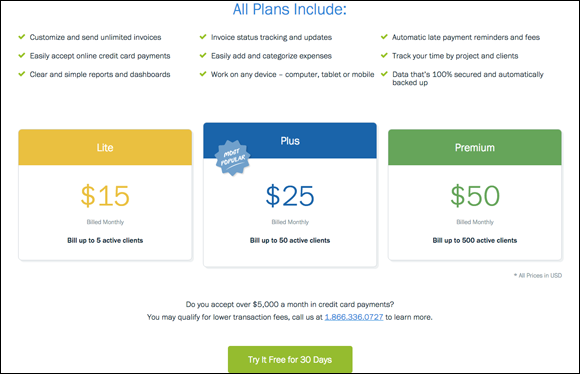
Source: https://www.freshbooks.com/pricing
FIGURE 3-1: This content on Freshbooks is designed to meet a prospective customer’s needs when looking for pricing.
For a prospective customer of Freshbooks to make an informed buying decision, the pricing page is necessary. Before they commit, people want to know what they're buying and how much it will cost. Failure to conveniently provide that information for the prospect will result in lost sales.
Understanding the marketing funnel
The path from stranger to buyer is often conveyed using the metaphor of a funnel. Ice-cold prospects enter the wide top of the funnel and some, you hope, exit through the much narrower bottom of the funnel as customers. Content can, and should, assist the prospect in graduating from one stage of the marketing funnel to the next.
A basic marketing funnel has three stages that take a prospect from stranger to buyer:
-
Awareness: The prospect must first become aware that he has a problem and that you or your organization can provide a solution.
 Raising problem and solution awareness is where your blog will shine. Use your blog to educate, inspire, or entertain prospects and existing customers.
Raising problem and solution awareness is where your blog will shine. Use your blog to educate, inspire, or entertain prospects and existing customers. - Evaluation: Those who move through the awareness stage must now evaluate the various choices available to them, including your competitor’s solutions and, of course, taking no action to solve the problem at all. People can, after all, decide to live with the problem and not purchase the product or service that could solve that problem.
- Conversion: Those who move through the evaluation stage are at the moment of truth — purchase. The goal at this stage is to convert leads into frequent and high-ticket buyers.

Source: http://www.digitalmarketer.com/content-marketing/
FIGURE 3-2: The three-step marketing funnel.
Cold prospects can’t evaluate your solution until they’re first aware of the problem and of your solution. If prospects are unaware of the problem or the solution that you offer through your product or service, they obviously won’t buy. Therefore, conversions are impossible until prospects have first evaluated the possible courses of action they can take, which include buying your product, buying a competitor’s product rather than yours, or doing nothing and living with the problem. To move prospects through a marketing funnel, you need to provide content designed to satisfy their needs at each of the three stages:
- Content at the top of the funnel (TOFU) that facilitates awareness.
- Content at the middle of the funnel (MOFU) that facilitates evaluation.
- Content at the bottom of the funnel (BOFU) that facilitates conversion.
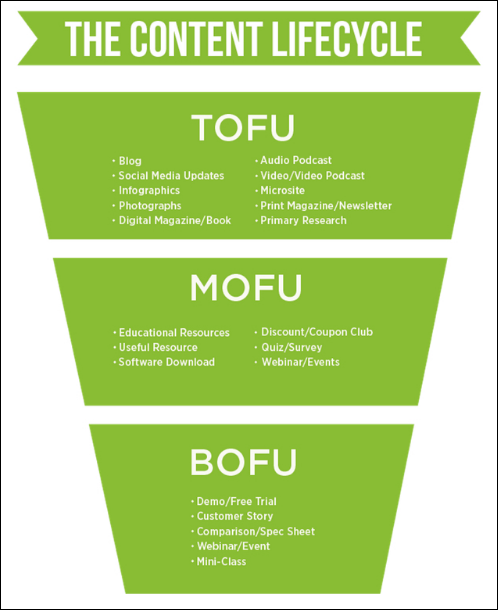
Source: http://www.digitalmarketer.com/content-marketing/
FIGURE 3-3: You need different content types at each stage of the marketing funnel.
Top of funnel content marketing
The prospects entering the top of your funnel (TOFU) are unaware of your solution and often unaware that they even have a problem that needs to be solved. As a result, you need content that people can freely access, as opposed to content that requires prospects to give you their contact information or make a purchase. After all, you have yet to prove your value to them.
At the top of the funnel, make free ungated (no password or email address required) content available that entertains, educates, or inspires.
Choose two to three of the following content types to deliver TOFU content that will raise awareness about the solutions you provide through your products or services:
- Blog posts: Arguably the most recognized form of online content, blogs are an excellent way of raising awareness. For example, the fashion company J. Crew raises awareness of the products it sells by creating blog posts about fashion styles and tips for accessorizing. The J. Crew blog reader (and potential customer) gets inspiration and solutions to the problem of what to wear and how to look fashionable; the post also alludes to the fact that J. Crew carries the clothing needed to pull off the look.
- Social media updates: As with blogs, social media platforms (such as Facebook) are fantastic at creating awareness. Whether it's a Pinterest board by Dreyer's Ice Cream that lists every flavor of ice cream the company sells, or a tweet by Airbnb about the ten perfect Paris food experiences, these social media updates give their followers free, valuable information while also bringing the solutions their company provides to the forefront.
-
Infographics: Infographics are an interesting and engaging way to display content. Typically, infographics contain fun images with contrasting, eye-catching colors, and the way infographics break up text makes this form of content easily consumable by the viewer. Infographics are highly effective at delivering content that is both entertaining and educational, quickly. Whether it's an infographic by IMDb about the best of the year in movie entertainment, or an infographic by Casper Mattress providing tips on better sleeping habits, this type of content delivers value that a consumer wants, and it raises brand awareness effectively as well.
 Creating infographics are a great way to repurpose content. People love them and they can help you reach more of your audience.
Creating infographics are a great way to repurpose content. People love them and they can help you reach more of your audience. - Photographs: Pictures are powerful because they can explain a lot in a single image. Photographs also help break up blocks of text in a piece of content, which keeps that content from becoming boring or intimidating to read. With a photograph, a kitchen design company can show completed projects that effectively demonstrate what the company does while raising awareness of what the company can do for another customer's kitchen.
- Digital magazines and books: Digital magazines and books are popular, and are another way to distribute content and raise brand awareness. Therefore, you can look to your blog to inspire your content for an ebook or e-magazine.
- Audio and video podcasts: Another form of content that you can use at the top of the funnel is a podcast. With a podcast, you package and distribute your content differently from textual content. A podcast delivers consumable content on the go. Subscribers can listen to the podcast on their commute to work or during their workout, or any other time they choose. They have a more flexible way to consume the content, in contrast to a blog post or a social media update that is less conducive to multitasking. Also, you can use podcasts to effectively promote your product or service while providing value to your prospects. If you sell outdoor equipment, for example, each episode of your podcast can give tips and tricks about hunting, fishing, camping, and other outdoor activities while also subtly reminding your listener of the outdoor equipment available at your store.
- Microsites: A microsite is essentially an auxiliary blog about a specific topic that is put on a different site with its own links and address; a microsite is accessed mainly from a larger site. For instance, DadsDivorce.com is a separate domain of the men's family law firm Cordell & Cordell. DadsDivorce.com provides free content for divorcing fathers and is designed to raise awareness about the services and solutions Cordell & Cordell can provide.
- Print magazines and newsletters: This type of content can require a bigger budget than digital content, but if going this route falls within your budget, print magazines and newsletters are still a great way to raise awareness. For example, the Lego Club Magazine contains plenty of entertaining comic book style content for Lego's target customer. Magazines and newsletters help sales by inspiring shoppers based on what they see in print.
- Primary research: This is research you go out and collect yourself, such as surveys, interviews, and observations. Although this data can be difficult and time consuming to gather, primary research is powerful because only a finite amount of primary research exists. Specifically, when you take the time to create research, you're providing a service and saving people from having to do their own primary research. For this reason, primary research can stir a good deal of awareness among your prospects.
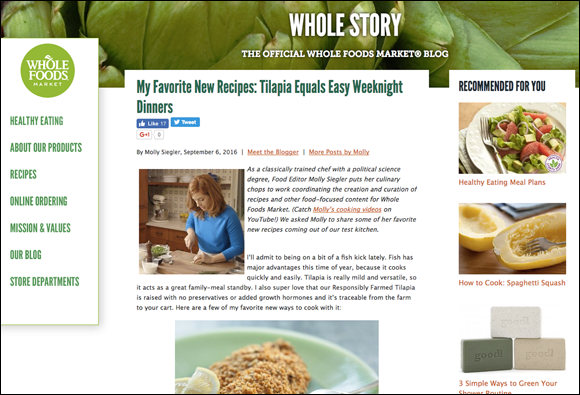
Source: http://www.wholefoodsmarket.com/blog/my-favorite-new-recipes-tilapia-equals-easy-weeknight-dinners-0
FIGURE 3-4: Whole Foods raises awareness of products it sells while providing value to its blog audience.
Unfortunately, the top of the funnel is where most organizations begin and end their content marketing efforts. Smart content marketers know that, with a bit more effort, they can move prospects from awareness to evaluation at the middle of the funnel.
Middle of funnel content marketing
The big goal for content you use at the middle of the funnel (MOFU) is to convert “problem aware” and “solution aware” prospects into leads. You're looking to grow your email lists and gain more leads at this point of the funnel. At DigitalMarketer, they use free content to incentivize prospects to submit their contact information (such as their email address) and opt in to receive future marketing in exchange for valuable content. This type of content is a gated offer, which you can find out more about in Book 1, Chapter 5.
Gated offers often take the form of content such as the following:
-
Educational resources: Educational resources for gated offers often exist in the form of free reports, white papers, primary research, webinar training, and sales material. These types of content resources educate the consumer on a particular topic related to your brand while highlighting features of a solution, product, or service you provide. An educational resource can include a case study packed with professional tips and a detailed breakdown of some of your strategies.
 Educational resources (and all forms of MOFU content, for that matter) must be of high quality or the consumer is likely to feel cheated. Also, if prospects feel that the content you gave them in exchange for their contact information is subpar, your brand awareness suffers. Keep in mind that the point of the MOFU is to help people evaluate your company and entice them to make a purchase. You entice with quality, not garbage.
Educational resources (and all forms of MOFU content, for that matter) must be of high quality or the consumer is likely to feel cheated. Also, if prospects feel that the content you gave them in exchange for their contact information is subpar, your brand awareness suffers. Keep in mind that the point of the MOFU is to help people evaluate your company and entice them to make a purchase. You entice with quality, not garbage. -
Useful resources: Useful resources are tools such as
- Handouts or cheat sheets
- Resource lists
- Templates
- Software
- Surveys
- Assessments
- Discount and coupon clubs
- Quizzes and surveys
These useful tools, which serve as powerful content for MOFU, are covered more in Book 1, Chapter 5. Instead of using a consumer's time (such as an ebook that may take an hour or more to read), useful resources promise that they will not only educate your prospects but also save them time. These resources save them time because the content is easy to consume and the resource is complete; it doesn’t depend on another resource to deliver its value but can stand alone. For example, a company that sells vegetable gardening tools can create a resource called the “Seed Starting Cheat Sheet” that allows people with an interest in gardening to quickly determine the best time to plant popular vegetables in the garden.
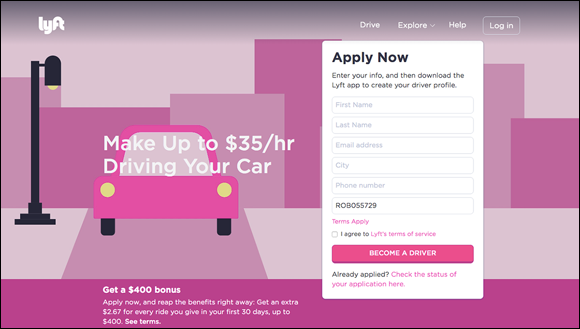
Source: https://www.lyft.com/drive-with-lyft?ref=ROB055729.
FIGURE 3-5: Rideshare company Lyft uses a landing page to start its driver application process.
The goal at the middle of the funnel is to convert prospects who were unaware of your product or service into people with whom you can now follow up. As they say, however, you can’t deposit leads in the bank. To generate revenue, you need content that assists your prospects in making decisions at the point of sale.
Bottom of funnel content marketing
At the bottom of the funnel (BOFU), you're looking to convert leads into customers and customers into higher-ticket customers. What types of content will your new lead need to make an informed purchase decision? Your leads may be reading your blog and downloading your gated offers (all of which helps to convert them), but to move them on through to the point of making a purchase, you also need to offer content that helps them decide whether to buy.
Here are examples of content types that work well at the bottom of the funnel:
- Demos: The downside of buying a product online is that customers can't hold the product in their hands — they have only an image (or two) and a description to base their purchasing decisions on, which can make people hesitate to buy. Offering a demo can help with this problem. A demo shows the product or service you offer in action, so that consumers can see how it works. It's as close to touching the product as they can get from their screen. So find a way to demonstrate your product or service through content such as video, screen shots, webinars, or schematic drawings.
- Customer stories: Customer stories are customer testimonials and reviews. Customer stories are fantastic at the bottom of the funnel because they allow a prospect to see how someone else experienced success with your product or service. You provide your prospects with peer reviews, which have a powerful effect on decision making. As shown in Figure 3-6, Salesforce.com supplies leads who are at the BOFU with plenty of customer success stories to prove that its product can take care of their needs.
- Comparison/spec sheets: When someone at the BOFU is debating over different products, comparisons and spec sheets are handy resources that people use to compare products side by side (whether the comparison is between similar products that you offer or between your product and your competitor's product). For example, the tax preparation software company TurboTax might show a side-by-side comparison to the features and pricing of its competitor, TaxAct.
- Webinars/events: You can use webinars and events at the middle of the funnel to gather leads, but you can also use them at the bottom of the funnel to convert those leads. At the bottom of the funnel, a webinar can be used to gather prospective customers in one place to ask questions about a complex, risky, or high-ticket product or service.
- Mini-classes: A mini-class is a type of event that you set up to teach a relevant topic to your target audience. At the end of the short class, you make your pitch for your product or service. You need to provide quality educational resources with the mini-class, but in the end, the purpose of the class is to pitch a higher-dollar product related to the class you just held.
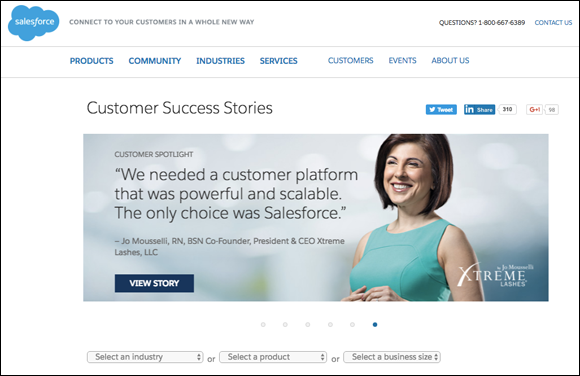
Source: http://www.salesforce.com/customers/
FIGURE 3-6: Salesforce creates content that converts at the BOFU by telling customer success stories.
Exploring the prospect’s intent
The key to perfect content marketing is to understand your prospects' existing intent so that you can anticipate their future intent and predict which path or paths they will take. In foreseeing this, you can create the content assets needed to address that intent 24 hours a day, seven days a week.
For example, Freshbooks (an online accounting company) customer in the evaluation or conversion stage of the funnel might intend to compare Freshbooks to QuickBooks. The web page shown in Figure 3-7 satisfies that intent at both the middle and the bottom of the funnel. Freshbooks gives the prospect a comparison sheet that allows the customer to see the differences between Freshbooks and its competition, QuickBooks. The company knows that prospective customers want to see how it stacks up against QuickBooks. Satisfying that intent in the evaluation stage helps prospects move into the conversion stage.
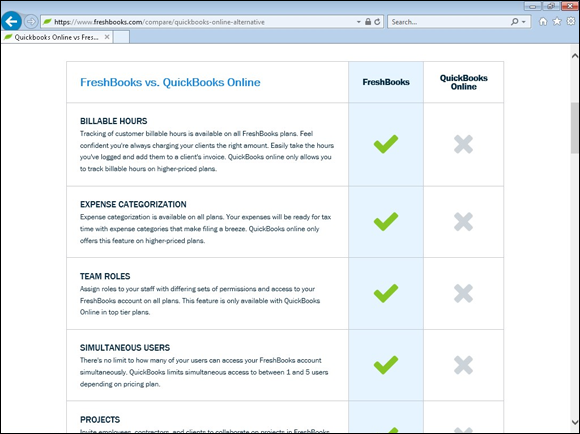
Source: https://www.freshbooks.com/compare/quickbooks-alternative
FIGURE 3-7: Freshbooks uses a comparison sheet to move a prospect closer to conversion.
Brainstorm lists of intent at the top, middle, and bottom of the funnel. Then decide what content assets need to be built to satisfy that intent from awareness through conversion.
Providing a path to the next step
As a marketer, you need to provide a path from one piece of content to the next. People are busy and don't have the time or the patience to go digging through your site for the proper piece of content. They need to be able to find what they're looking for fast.
Failing to provide an easy-to-follow path to the next step isn’t just bad marketing, it’s a bad user experience, one that will cause people to click the Back button on thier browsers and leave your site. Smart content marketers anticipate the next logical intent and remove as much “friction” as possible to create a clear path to conversion.
The goal of every piece of content is to get the prospect to ascend to the next logical step in the buyer journey. In the Freshbooks pricing page example shown in Figure 3-8, notice that Freshbooks has created a clear ascension path to a “Risk-Free Trial” of the software. Creating an ascension path is good marketing and results in a good user experience.
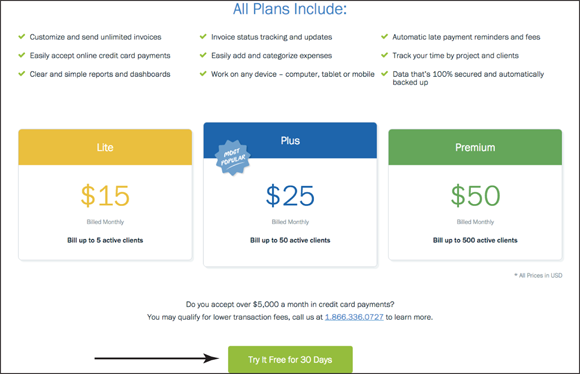
Source: https://www.freshbooks.com/pricing
FIGURE 3-8: Freshbooks anticipates the next logical intent of a visitor who needs to obtain pricing information.
Segmenting your marketing with content
You won't truly understand your audience and what people really want until they have given you one of two things: their time or their money. They may answer survey questions and make comments that they’re interested in this or that, but until they have committed a precious resource — time or money — you don't know for sure what interests them. This is good news for anyone creating content online, because when people spend time with content, they’re showing interest.
For example, imagine that you own a company that sells healthy and nutritious meals to busy professionals, and you've been creating blog content about nourishing recipes. Your content falls into three main categories of recipes: vegan, vegetarian, and gluten free. What do you know about someone who visits a blog post about vegan recipes? Likewise for someone visiting a blog post about vegetarian recipes. It's pretty clear, right? These people have “raised their hands” and told you that they are (or are interested in becoming) vegan or vegetarian.
When people spend their valuable time consuming content, they’re segmenting themselves. They’re telling you what interests them. And thanks to the magic of ad retargeting, you can follow up with these prospects by using a relevant ascension offer without having to acquire their contact information.
Retargeting is the process of advertising to people based on their prior behavior. For example, you can configure retargeting ads so that they appear only to customers who bought a particular product or visited (showed interest) a particular product page or blog post. This approach allows you to show a very specific piece of content that is more likely to resonate with the segmented audience. Turn to Book 5, Chapter 1 for more information on ad retargeting strategies.
Appearing everywhere your customerexpects
Marketers who want to create perfect content need to publish where their customers are. That means publishing content that meets prospects' intent in any channel, and at every stage of the funnel where groups of prospects are searching for and sharing content. These channels include but are certainly not limited to the following:
- A website or blog
- YouTube
You can publish a single content asset across numerous channels to maximize exposure. For instance, at DigitalMarketer (http://digitalmarketer.com), they turned a presentation about how to launch a podcast into a webinar, and then into a podcast episode, and finally into a blog post. Because their audience responded so enthusiastically to this content, they saw the value and the need to repurpose it and distribute it throughout their channels.
Consider what content from your company has resonated with your audience. For example, can that video demo of your product be republished on your YouTube channel? Can you repurpose an article from your blog into a webinar, or a podcast episode into an article for LinkedIn Pulse? The opportunities to repurpose content are virtually limitless.
Customizing your content
You produce content marketing materials to satisfy the intent of your customer persona (also known as target audience). But not all personas are the same; they, like their real-life counterparts, don't all want or need the same solution. That's why customizing and then segmenting your content is essential. A particular piece of content can satisfy the intent of multiple personas, or you can use it to target a single persona.
For example, Digital Marketer produced a blog article called “6 Trending Digital Marketing Skills to Put on a Resume” to raise awareness (top of the funnel) for their marketing certification programs. This post probably wouldn't interest small business owners, but that was fine — they weren't targeting them. This article was specifically targeted to their “employee” persona whose intent is to acquire skills that will land her a better job. Included in the post are two calls to action, which is an instruction to your audience designed to convey urgency and provoke an immediate response. In the case of the trending skills blog post, the calls to action were customized to appeal to the “employee” persona.
Executing Perfect Content Marketing
As discussed earlier in this chapter, to execute perfect content marketing, you need a plan. Each offer you make often requires the creation of different pieces of content. As a result, the ideal is to make a content plan for each of your major offers using a resource the DigitalMarketer calls the Content Campaign Plan. The Content Campaign Plan aligns your content marketing with business objectives such as generating leads and sales. You can see the Content Campaign Plan template in Figure 3-9 and can fill out your own by visiting www.digitalmarketer.com/content-campaign.

Source: https://docs.google.com/spreadsheets/d/1Z29wImPl7PgJwQMv2TFr-RyOu_THBu1pXlOxJgjUtEw/edit#gid=0
FIGURE 3-9: The Content Campaign Plan organizes your content strategy for each individual product or service offer.
Following are the steps to create a Content Campaign Plan:
- Choose personas.
- Brainstorm content assets.
- Choose the vehicle and channel.
- Plan for ascension.
Read on to find out more about each of these steps.
Step 1: Choosing personas
Decide which personas this content targets. Because each persona has different intents, motivations, and problems he responds to, each persona requires different content to move him through the awareness, evaluation, and conversion stages. You therefore need to determine which existing content to use or what new content to create to move the persona through the top, middle, and bottom of the funnel.
For example, a wealth management firm attempting to sell financial planning should approach a young professional much differently than a near retiree. Some content will appeal to both, but the most effective content will speak directly to a specific persona.
Step 2: Brainstorming content assets
Use what you know about your customer persona to create descriptions for content that you can create to reach that persona.
Step 3: Choosing the vehicle and channel
The vehicle of the content refers to the form the content will take. Will it be text, an image, a video, or an audio asset? The channel refers to where the asset will be published — such as your blog, a Facebook Page, or a YouTube channel.
The vehicle can sometimes determine the channel, and vice versa. For example, a video asset often gets published on YouTube, Facebook, and your blog, whereas an image asset is more likely to be on Pinterest.
Step 4: Planning for ascension
In the final step of the Content Campaign Plan, you connect your content to your business goals. Build offers into each piece of content that allow prospects to get more value, either by consuming more content, giving you their contact information for follow-up, or buying a product or service.
Distributing Content to Attract an Audience
Today, content plays an important role in all major forms of traffic generation. Convincing cold (and even warm) prospects to visit your website is difficult without first leading with valuable content.
The processes you develop to distribute content, and thus generate traffic to it, are as important as the processes surrounding the creation of that content. Entire chapters of this book are devoted to the nuances of traffic generation using the methods of email marketing, search, social media, and paid traffic. However, it's worth mentioning how each of these major traffic generation methods interact with the content you produce.
Marketing through email
Email is still the best method for making offers and sending more content, so growing and maintaining your email lists are critical tasks, which is why growing your email list is built into your content strategy. After you've produced a content asset, such as a blog post or a podcast episode, use your email list(s) to drive traffic to that piece.
To write the email for your new piece of content, first create the subject line of the email message. Often the subject is the same as the title of the content, but there are other strategies to naming your email subject line, such as scarcity headings like “FINAL notice (Just hours left …)” or by piquing curiosity with subject lines like “THIS is why I do what I do ….”
Next, open your email with a short, punchy introduction that pulls people into the main body of your email, where you pique the email subscriber's interest and describe what he can expect from the content. Explain this email’s relevance to the reader and what he has to gain from it (also known as the benefit). Also, be sure to include a call to action that instructs the subscriber to click the hyperlink to your content. Use two to three hyperlinked calls to action to make clicking them as convenient as possible.
Capturing leads through search marketing
Search engines, such as Google and Bing, are important content distribution channels to leverage. When prospects reach your site by querying a search engine (they might be searching for “dslr camera reviews” or “crepe recipes” in Google or Bing) but haven’t selected an ad, they’re using search marketing. The traffic driven to that content wasn't paid for but was found naturally by the users.
Using social media to drive traffic to your site
After you have created a piece of content, use the social media platform(s) that your business participates in to drive traffic to that content. Books 7 and 8 go more in depth about how to use social media sites, but for now, be aware that driving traffic on social media may take several forms, such as a tweet on Twitter or an update on Facebook or LinkedIn. This update announces the new content and provides a hyperlink to it.
When you write text for a social media update, your brand's personality should determine how you announce this new content. For instance, if your brand is a refined jewelry store, you may want to use a formal tone in your copy.
The length of the copy depends on restrictions (such as on Twitter) and the complexity of the offer. Simple offers don't require the same amount of description as complex offers do. Regardless of the length of the copy, be sure that the social media update piques the viewer’s curiosity, describes the benefit of the content, and has a clear call to action, such as the home improvement store Lowe's Facebook post shown in Figure 3-10. This social media update meets all three of these requirements effectively.
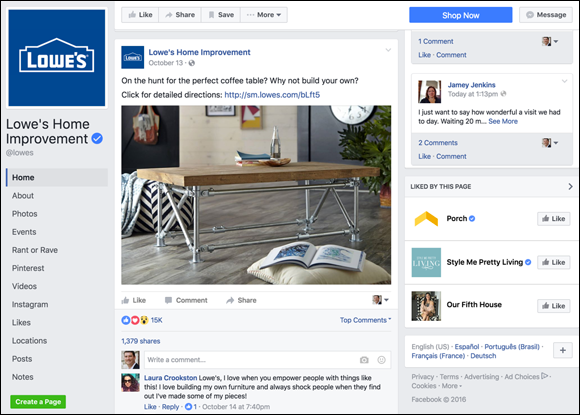
Source: https://www.facebook.com/lowes/posts/10153827254486231:0
FIGURE 3-10: On Facebook, Lowe's establishes the benefit of the content and gives a clear call to action for the viewer to click.
Paying for traffic
As the name suggests, paid traffic takes the form of ads that promote your content and helps your content gain reach, or exposure. You can display ads on many different platforms, including search engines and social media. Paid traffic can be highly effective at generating leads because it helps you to segment your visitors and make use of retargeting.
Although many marketers may be reluctant to pay to send traffic to content, such as blog posts and podcasts, paid traffic has a major advantage: It's predictable. When you cut a check to Facebook, for example, to promote a piece of content, you will get traffic. This is why, at all times but especially when buying ads for your content, you must ensure the exceptional quality of your content. The last thing you want to do is spend money to send traffic to poor-quality content.
Use paid traffic to promote quality content that gives value to the consumer and aligns with your business goals. This will help you move people from one part of the funnel to the next, progressing from ice-cold prospect to a lead to customer to repeat customer and, ideally, to raving fan.
 Don't pin all your lead-generation hopes to a passive gated offer on your home page or the sidebar of your blog, because the gated offer can get lost among the many elements of your site. A missed gated offer won’t capture leads. Be sure to also create a dedicated landing page for every gated offer (some call this a squeeze page) and drive traffic directly to that page using social media, email marketing, search engine optimization (SEO), and paid traffic. A dedicated landing page increases opt-ins. See
Don't pin all your lead-generation hopes to a passive gated offer on your home page or the sidebar of your blog, because the gated offer can get lost among the many elements of your site. A missed gated offer won’t capture leads. Be sure to also create a dedicated landing page for every gated offer (some call this a squeeze page) and drive traffic directly to that page using social media, email marketing, search engine optimization (SEO), and paid traffic. A dedicated landing page increases opt-ins. See